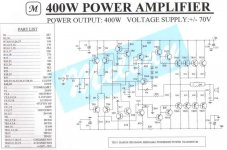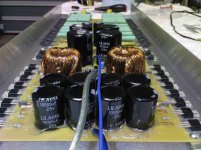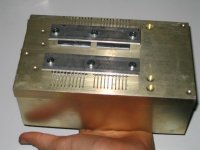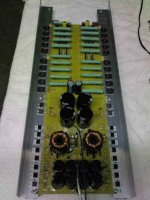I built this amp X2 (see attachment) as a two channel car amp
It works great, I've biased it to about 20ma
If I push the amp I keep having thermal runaway. Obvoiusly I've done something stupid somwhere...... and it's cost me a small fortune in output transistors. I've tried almost no bias as well (5ma)with the same result.
Is TR10 supposed to be attached to the heatsink?
Any ideas?
It works great, I've biased it to about 20ma
If I push the amp I keep having thermal runaway. Obvoiusly I've done something stupid somwhere...... and it's cost me a small fortune in output transistors. I've tried almost no bias as well (5ma)with the same result.
Is TR10 supposed to be attached to the heatsink?
Any ideas?
Attachments
The bias components (transistor and diodes) need to be attached to the heatsink. You may be able to mount only the transistor on the sink for proper compensation but having all of them should provide better compensation.
Insert 5 amp fuses in the positive and negative rails between the supply and the amplifier. This will allow you to run the amp hard enough to make it heat up but should protect the power supply and the outputs. Drive it as hard as you can without blowing the fuses. Every couple of minutes, remove the input signal and re-check the bias current. Do this until it gets as hot as you intend to run it. If you have thermal protection, continue to check the bias current until it reaches thermal shutdown.
Insert 5 amp fuses in the positive and negative rails between the supply and the amplifier. This will allow you to run the amp hard enough to make it heat up but should protect the power supply and the outputs. Drive it as hard as you can without blowing the fuses. Every couple of minutes, remove the input signal and re-check the bias current. Do this until it gets as hot as you intend to run it. If you have thermal protection, continue to check the bias current until it reaches thermal shutdown.
Thanks Perry
Will try that.
I've realised again just how destructive thermal runaway can be. Fuses are essential.
Will try that.
I've realised again just how destructive thermal runaway can be. Fuses are essential.
Is this circuit correct?
Is this circuit correct?
I have moved the transistors and diodes now, and it's a bit better.
What seems to be happening is both rails of output transistors turn on at high volume or high power transients, just below this level I can let the amp get very hot and it has no problem.
Only occurs with peaks
Is this circuit correct?
I have moved the transistors and diodes now, and it's a bit better.
What seems to be happening is both rails of output transistors turn on at high volume or high power transients, just below this level I can let the amp get very hot and it has no problem.
Only occurs with peaks
If the bias current holds at all normal operating temperatures but it spikes for a few seconds just after a period of very high power output, the bias components are not close enough to the output transistors. The temperature of the output transistors is increasing but the temperature of the heatsink where the bias components are mounted is significantly cooler than the output transistors. Move the bias components as close to the outputs as possible.
This can also happen when the insulator material between the transistor and the sink is inefficient. The transistor sees a spike in temperature and it takes longer than it should for it to pass the heat to the sink. As the transistor returns to the temperature of the heatsink, the bias current returns to normal.
This can also happen when the insulator material between the transistor and the sink is inefficient. The transistor sees a spike in temperature and it takes longer than it should for it to pass the heat to the sink. As the transistor returns to the temperature of the heatsink, the bias current returns to normal.
Maybe I should those thermaltrak output transistors I have lying around.
It's awkward to move that whole circuit to the heatsink, what would you reccomend is the minimum components?
Thanks for the advice so far.
It's awkward to move that whole circuit to the heatsink, what would you reccomend is the minimum components?
Thanks for the advice so far.
You should try heating the bias circuit components individually to see which one causes the greatest change in bias current. Heat the diodes as a group. If heating the transistor alone creates a significant change in bias current, try relocating only the transistor. If both the diodes and the transistor make a big difference in bias current and moving the transistor alone doesn't provide enough compensation, you'll have to move all of them.
If you mount them on a small piece of proto-board, they will be easier to relocate as a group.
If you mount them on a small piece of proto-board, they will be easier to relocate as a group.
I deserved that nice logical answer!
I could relocate most of it with two wires and proto board.
Once I get that right, I'd like to increase the VAS (not sure the drivers are being driven hard enough)
Once it's stable I will post the PCB I have done, which was designed to fit into a standard type car amp heatsink😀
I could relocate most of it with two wires and proto board.
Once I get that right, I'd like to increase the VAS (not sure the drivers are being driven hard enough)
Once it's stable I will post the PCB I have done, which was designed to fit into a standard type car amp heatsink😀
Hi
Which is? there are standards for that??fit into a standard type car amp heatsink
No, I mean the average size is often 200 -210mm inside for the heatsink.
The amp and SMPS are about 190 wide, so a borrowed heatsink can often be used.
Where can I buy proper car amp heatsink, cannot find any locally?
The amp and SMPS are about 190 wide, so a borrowed heatsink can often be used.
Where can I buy proper car amp heatsink, cannot find any locally?
Heated TR 9,10,11 and diodes
Heated TR 9,10,11 and diodes separately and all that happens is the bias current goes up very slightly, I mean like 2mV
I think I'l put the diodes alone on the heatsink
Heated TR 9,10,11 and diodes separately and all that happens is the bias current goes up very slightly, I mean like 2mV
I think I'l put the diodes alone on the heatsink
I'd recommend the ThermalTraks if you have them......
And look around for big heatsinks of several kinds, you want good heatsinks to avoid thermal runaway!
I went to an Electronic Surplus outlet in my state to get big heatsinks, and its hit or miss with that, depends on what they may have on hand, but I managed to get some monster heatsinks. 😀
See if a repair shop has some old car-amp heatsinks or try a surplus outlet. There's also a guy on Ebay that sells it by the foot, so you have to use what options are availiable to you to get good heatsinks. I've collected heatsinks, and used them years later because good ones are hard to find sometimes.
I'm using the ThermalTrak in my new design. This was because I didn't want the trouble of mounting extra parts for thermal compensation, and the built in diodes are convienient!
On this pic, the ThermalTraks are the main devices.
On another amp (subwoofer) I use the Thermaltraks as drivers to compensate for the temp of several pairs of outputs (all on the same heatsink)
And look around for big heatsinks of several kinds, you want good heatsinks to avoid thermal runaway!
I went to an Electronic Surplus outlet in my state to get big heatsinks, and its hit or miss with that, depends on what they may have on hand, but I managed to get some monster heatsinks. 😀
See if a repair shop has some old car-amp heatsinks or try a surplus outlet. There's also a guy on Ebay that sells it by the foot, so you have to use what options are availiable to you to get good heatsinks. I've collected heatsinks, and used them years later because good ones are hard to find sometimes.
I'm using the ThermalTrak in my new design. This was because I didn't want the trouble of mounting extra parts for thermal compensation, and the built in diodes are convienient!
On this pic, the ThermalTraks are the main devices.
On another amp (subwoofer) I use the Thermaltraks as drivers to compensate for the temp of several pairs of outputs (all on the same heatsink)
Attachments
WOW, you don't go easy on the heatsinks! I don't think you will have any heating problems there😀
If you ever consider posting that thermal track design, look me up please....
If you ever consider posting that thermal track design, look me up please....
- Status
- Not open for further replies.
- Home
- General Interest
- Car Audio
- Thermal runaway question




